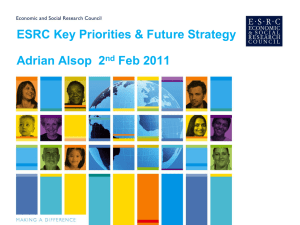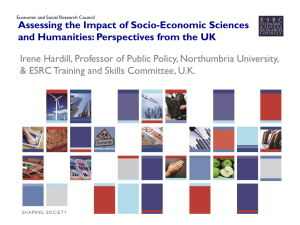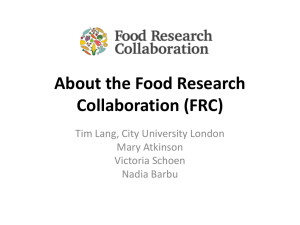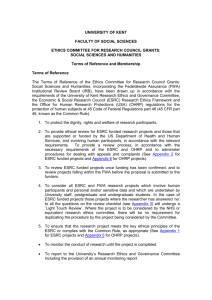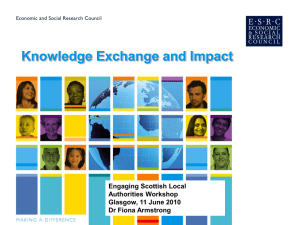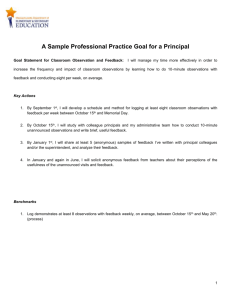A: To be completed by Grant Holder
advertisement
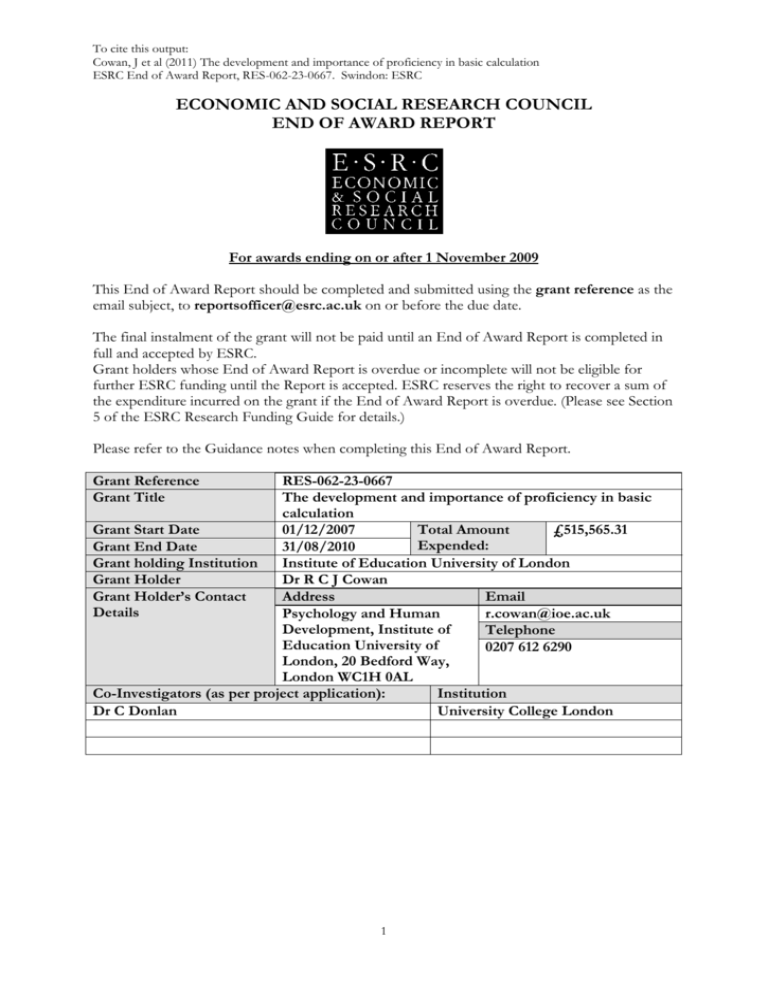
To cite this output: Cowan, J et al (2011) The development and importance of proficiency in basic calculation ESRC End of Award Report, RES-062-23-0667. Swindon: ESRC ECONOMIC AND SOCIAL RESEARCH COUNCIL END OF AWARD REPORT For awards ending on or after 1 November 2009 This End of Award Report should be completed and submitted using the grant reference as the email subject, to reportsofficer@esrc.ac.uk on or before the due date. The final instalment of the grant will not be paid until an End of Award Report is completed in full and accepted by ESRC. Grant holders whose End of Award Report is overdue or incomplete will not be eligible for further ESRC funding until the Report is accepted. ESRC reserves the right to recover a sum of the expenditure incurred on the grant if the End of Award Report is overdue. (Please see Section 5 of the ESRC Research Funding Guide for details.) Please refer to the Guidance notes when completing this End of Award Report. Grant Reference Grant Title RES-062-23-0667 The development and importance of proficiency in basic calculation Grant Start Date 01/12/2007 Total Amount £515,565.31 Expended: Grant End Date 31/08/2010 Grant holding Institution Institute of Education University of London Grant Holder Dr R C J Cowan Grant Holder’s Contact Address Email Details Psychology and Human r.cowan@ioe.ac.uk Development, Institute of Telephone Education University of 0207 612 6290 London, 20 Bedford Way, London WC1H 0AL Co-Investigators (as per project application): Institution Dr C Donlan University College London 1 To cite this output: Cowan, J et al (2011) The development and importance of proficiency in basic calculation ESRC End of Award Report, RES-062-23-0667. Swindon: ESRC 1. NON-TECHNICAL SUMMARY Please provide below a project summary written in non-technical language. The summary may be used by ESRC to publicise your work and should explain the aims and findings of the project. [Max 250 words] Primary school children differ hugely in their mathematics attainment. Although mathematics is more than computation, a surprisingly substantial correlate of attainment is simple computational skill, involving numbers less than 20. This project aimed to understand more about how simple computational skill develops and why it is related to mathematics attainment. We assessed the skills and number understandings of over 250 children in Year 3 and again in Year 4. We also collected information on other measures that previous studies had shown to be related to children’s mathematical attainment. These included social factors, such as parental support, cognitive factors, such as memory and language, and other number skills, such as number sense. Understanding of number and computational skill were highly related. Nevertheless the results were more consistent with idea that skill develops from understanding. Understanding better predicted later skill than skill predicted later understanding. Our data suggest simple computational skill is mainly related to more general maths attainment because both are affected by the same factors. There is very little diversity in maths attainment that can only be explained by simple computational skill. Also simple computational skill is not necessary for high mathematics attainment. Even children who were very advanced for their age did not know all the number facts and many children who were doing well made occasional mistakes on simple sums. Imperfect skill in simple computation is not the barrier to success it is often assumed to be. 2. PROJECT OVERVIEW a) Objectives Please state the aims and objectives of your project as outlined in your proposal to the ESRC. [Max 200 words] The aims were a) to establish the relations between skill in basic computation and conceptual knowledge, b) to assess explanations for the association between proficiency in basic computation and general measures of mathematics attainment, and c) determine whether covariation between basic calculation skill and mathematics is due to other factors The objectives were to: Collect data on basic calculation skill and conceptual knowledge in Year 3 and 4 Assess general cognitive factors and other numerical knowledge and skills Test children's mathematics, reading, and language, and obtain teacher assessments of these together with socio-emotional functioning 2 To cite this output: Cowan, J et al (2011) The development and importance of proficiency in basic calculation ESRC End of Award Report, RES-062-23-0667. Swindon: ESRC Interview teachers about mathematics instruction and observe them teach Estimate parental involvement from teachers' reports of contact with parents, completion of homework, and unexplained absences Assess socioeconomic status, economic stress, and neighbourhood quality from information about parental occupation, child's eligibility for free school meals, and current address Use the data obtained to develop theoretical understanding of the relations between basic calculation proficiency and number principle knowledge and between basic calculation proficiency and more general mathematical attainment To discuss with the partner educational authority and participating schools the findings and their implications To disseminate the findings to both academic and professional audiences b) Project Changes Please describe any changes made to the original aims and objectives, and confirm that these were agreed with the ESRC. Please also detail any changes to the grant holder’s institutional affiliation, project staffing or funding. [Max 200 words] No changes to original aims and objectives apart from dropping the observations of teaching at the request of participating schools. Also children were not video recorded following consultation with the schools. As a result neither the video recording equipment nor the computer for video editing budgeted for in the proposal were bought. Standardized measures were used to assess processing speed and rapid naming: processing speed assessed by the Symbol Matching subtest from WISC III UK (Wechsler, 1992) and the Pair Cancellation subtest from Woodcock-Johnson III (Woodcock, McGrew, & Mather, 2001); rapid naming assessed by the tasks from CTOPP (Wagner, Torgesen, & Rashotte, 1999). Reading was assessed by the Test of Word Reading Efficiency (TOWRE, Torgesen, Wagner, & Rashotte, 1999) and the York Assessment of Reading Comprehension (YARC, Snowling et al., 2009) instead of the WIAT II UK (Wechsler, 2005) as advice from reading researchers suggested these would be better. The addition measure from the Dyscalculia Screener (Butterworth, 2003) was only administered in Year 3 and dropped from the measures of basic calculation proficiency. This was because of difficulties in administration and its weaker relationship with other measures of basic calculation proficiency. 3 To cite this output: Cowan, J et al (2011) The development and importance of proficiency in basic calculation ESRC End of Award Report, RES-062-23-0667. Swindon: ESRC c) Methodology Please describe the methodology that you employed in the project. Please also note any ethical issues that arose during the course of the work, the effects of this and any action taken. [Max. 500 words] Participants There were 259 Year 3 children (125 girls, 134 boys) whose parents signed consents for them to participate. This was 85% of the eligible children in 7 participating schools in Windsor and Maidenhead. All schools with year 3 and 4 pupils had been invited to participate. Basic computation and conceptual knowledge measures Computational fluency: a forced retrieval task assessing number fact knowledge and a second task assessing strategy use. Conceptual knowledge: a derived facts task involving application of arithmetical principles to solve problems and a second task soliciting description and explanation of number principles and patterns. All children were tested on these in Year 3 and again one year later. Control measures Standardized tests were used to assess oral language (TROG-E, Bishop, 2005; BPVS II, Dunn, Dunn, Whetton, & Burley, 1997), working memory (WMTB-C, Pickering & Gathercole, 2001), processing speed (Symbol Matching; Pair Cancellation), general ability (Raven, 2008), reading (TOWRE, YARC), and RAN (CTOPP). Socio-emotional functioning was estimated from teacher- completed Strengths and Difficulties Questionnaires (Goodman, 1997) for each child in both years. Parental involvement was estimated from teachers’ ratings of parental interest in educational progress. All teachers were interviewed to establish their orientation to mathematics teaching. Schools provided information about the children’s SEN status, attendance during the year of participation in the project, take up of free school meals (FSM), and residential postcodes. Postcodes were categorized using the English 2007 Index of Multiple Deprivation (IMD). Social class was ascertained from parents’ responses using the three-class version of the NSSEC. Number sense measures Number sense was assessed with Dot Enumeration and Numerical Stroop tests from the Dyscalculia Screener and a number system knowledge composite of items from the Number Knowledge test (Griffin, 1997) and count sequence tests (Cowan, Donlan, Newton, & Lloyd, 2005) requiring oral and written responses. 4 To cite this output: Cowan, J et al (2011) The development and importance of proficiency in basic calculation ESRC End of Award Report, RES-062-23-0667. Swindon: ESRC Attainment measures Teachers rated the children’s National Curriculum levels in Mathematics. Children were assessed on the Numerical Operations and Mathematical Reasoning subtests of WIAT IIUK. Preliminary data treatment Internal reliabilities of measures using Cronbach’s alpha ranged from .77 to .98. Only three variables were not statistically significantly related to attainment. They were FSM, IMD and social class. The lack of relation with these variables probably reflected the bias toward wealthier families in our sample: few (5.4%) claimed FSM, few (6.8%) lived in neighbourhoods that were more deprived than the national average, and most (71%) had household reference persons with professional or managerial occupations. Further analysis Scores for single measures and composites were transformed into normally distributed variables for further analysis. Multiple regressions were used to assess the overall amount of variance explained and the unique contribution of each variable to explaining variance. Although some predictor variables correlated substantially there were no multicollinearity problems. To assess the relations between computational fluency and conceptual knowledge and between basic computation and mathematical attainment, hierarchical multiple regressions were conducted with control factors entered in Step 1, number sense variables in Step 2, and Year 3 computational fluency and conceptual knowledge in Step 3. d) Project Findings Please summarise the findings of the project, referring where appropriate to outputs recorded on ESRC Society Today. Any future research plans should also be identified. [Max 500 words] In what follows the results of the Step 3 regressions, which include all variables, are summarized. The relation between computational fluency and conceptual knowledge For Year 4 computational fluency, significant contributions to explaining variance were Year 3 computational fluency (14% of variance uniquely accounted for), conceptual knowledge (1%), and socio-emotional functioning (1%). The overall R2 was .77. For Year 4 conceptual knowledge, the significant predictors were Year 3 conceptual knowledge (3%), number system knowledge (2%), reading (1%), processing speed (1%), 5 To cite this output: Cowan, J et al (2011) The development and importance of proficiency in basic calculation ESRC End of Award Report, RES-062-23-0667. Swindon: ESRC and parental support (1%). The overall R2 was .64. So whereas Year 3 conceptual knowledge uniquely predicted variation in both later fluency and conceptual knowledge, Year 3 computational fluency only contributed to explaining variation in later fluency. The relation between basic calculation proficiency and more general mathematical attainment Significant predictors of National Curriculum Mathematics were number system knowledge (2%), Year 3 computational fluency (1%), Year 3 conceptual knowledge (1%), reading (1%), general ability (1%), working memory central executive (1%), and socio-emotional functioning (1%). The overall R2 was .66. Predictors of WIAT Numerical Operations were Year 3 computational fluency (4%), number system knowledge (2%), Year 3 conceptual knowledge (1%), general ability (1%), working memory visuo-spatial sketchpad (1%), and age (1%). The overall R2 was .77. Predictors of WIAT Mathematical Reasoning were Year 3 computational fluency (4%), number system knowledge (1%), general ability (1%), oral language (1%), and school attendance (1%). The overall R2 was .74. Although computational fluency made the largest contribution of any variable to explaining variance on both WIAT tests the amount of variance it uniquely accounted for was small (4%) and it accounted for even less on National Curriculum Mathematics. School effects Analyses of covariance indicated no significant difference between schools in means on any measure. Separate analyses of correlations between variables for each school also indicated no substantial difference in patterns of relationships. Implications This study replicated findings that basic computational fluency is highly related to mathematics attainment. However the amounts of variance in attainment it uniquely accounted for were small and it did not predict later conceptual knowledge. Inspection of absolute performance indicated that children with superior mathematics attainment typically knew few facts. They predominantly used decomposition strategies to solve basic computation problems. Overall the findings lead us to propose that basic computational fluency is important diagnostically because it reflects understanding of number and mathematical progress rather than because it is necessary for their development. Further work Number line estimation was also assessed in Year 4. Parents were asked about children’s playing of games involving computation, and receipt of extra tuition in mathematics. We are assessing the contributions of these to explaining diversity. 6 To cite this output: Cowan, J et al (2011) The development and importance of proficiency in basic calculation ESRC End of Award Report, RES-062-23-0667. Swindon: ESRC Collaborations with other researchers in studies of number development in atypical children (low birthweight, ASD, William’s syndrome, Apert Syndrome) using project tasks are being discussed. Comparing interventions designed to enhance computational fluency with those focusing on number system knowledge and other conceptual knowledge would provide a way of testing the proposed explanation of the link between basic calculation proficiency and mathematics attainment. e) Contributions to wider ESRC initiatives (eg Research Programmes or Networks) If your project was part of a wider ESRC initiative, please describe your contributions to the initiative’s objectives and activities and note any effect on your project resulting from participation. [Max. 200 words] N/A 3. EARLY AND ANTICIPATED IMPACTS a) Summary of Impacts to date Please summarise any impacts of the project to date, referring where appropriate to associated outputs recorded on ESRC Society Today. This should include both scientific impacts (relevant to the academic community) and economic and societal impacts (relevant to broader society). The impact can be relevant to any organisation, community or individual. [Max. 400 words] Direct academic impacts of the project have been achieved through circulating draft papers to academic colleagues across the world presenting papers at academic conferences (ATINER, 2009, BERA 2009, BPS Developmental Section 2009 & 2010) discussing interim findings with psychology, education, and mathematics education audiences at university seminars (Oxford Department of Educational Studies, Newcastle Psychology Department, Mathematics Education Special Interest Group, Institute of Education) sharing data and experimental tasks with other researchers involving established collaborators from the Complutense University of Madrid in discussing the project, reviewing the data on audio files, and designing further studies (a Visiting Research Associate from Madrid is currently based at the Institute of Education attached to Professor Cowan) incorporating project data into teaching at Master’s level in general sessions and supervising dissertation projects by students on Master’s programmes in Special and Inclusive Education, Child Development, and Psychology of Education Indirect academic impacts have been achieved by organizing a British Journal of Educational Psychology sponsored conference on Understanding number development and difficulties in 2008. This conference in the Psychological Aspects of Education – Current Trends series was attended by over 130 delegates from academic departments across Europe with interests 7 To cite this output: Cowan, J et al (2011) The development and importance of proficiency in basic calculation ESRC End of Award Report, RES-062-23-0667. Swindon: ESRC in primary school children’s mathematical development and representatives from local authorities with responsibilities for primary mathematics and teachers from primary schools. The conference provided many opportunities to discuss the project. The resultant monograph edited by Cowan, Saxton, and Tolmie (2010) featured the introductory keynote by Cowan and Saxton (2010). Dissemination of the project was further facilitated by its inclusion as a case study in the Institute of Education’s 2009 brochure Research at the Institute of Education. This brochure was distributed widely at academic conferences around the world. Both research officers on the project have progressed to further positions, one as a universityfunded doctoral student, the other to work on other research projects at the Institute of Education. Economic and societal impacts so far have been derived from sharing the findings and project tasks with staff at participating schools providing sessions for parents at participating schools giving keynote addresses on the project with follow up workshops to two cohorts of primary teachers on the Mathematics Specialist Teacher Programme, the government initiative following the Williams review. b) Anticipated/Potential Future Impacts Please outline any anticipated or potential impacts (scientific or economic and societal) that you believe your project might have in future. [Max. 200 words] Academic impacts Papers in preparation: ‘The relation between proficiency in basic calculation and mathematics attainment in elementary school’.(for Journal of Educational Psychology) ‘Understanding the relation between number line estimation and mathematics attainment’. (for Journal of Experimental Child Psychology) 'Evaluation of a screening procedure for developmental dyscalculia'. (for Journal of Child Psychology and Psychiatry) Further papers will relate to additional ongoing analyses. Economic and societal impacts In consultation with ESRC and the Institute of Education Press office press releases will be prepared in anticipation of media interest. Brief papers will be prepared for professional journals. We shall inform debate about reform of the primary mathematics curriculum by presenting a report of the project and its findings to the Ministers and their advisers at the Department for Education and to the Education Select Committee. This will also be deposited with the 8 To cite this output: Cowan, J et al (2011) The development and importance of proficiency in basic calculation ESRC End of Award Report, RES-062-23-0667. Swindon: ESRC House of Commons library. Presentations and discussions of project data will be made to professional audiences including future cohorts of teachers on the Mathematics Specialist Teacher Programme, classroom teachers, SENCOs, educational psychologists. We are well placed to ensure wide dissemination through the Special Educational Needs Joint Initiatives network. You will be asked to complete an ESRC Impact Report 12 months after the end date of your award. The Impact Report will ask for details of any impacts that have arisen since the completion of the End of Award Report. 9 To cite this output: Cowan, J et al (2011) The development and importance of proficiency in basic calculation ESRC End of Award Report, RES-062-23-0667. Swindon: ESRC 4. DECLARATIONS Please ensure that sections A, B and C below are completed and signed by the appropriate individuals. The End of Award Report will not be accepted unless all sections are signed. Please note hard copies are NOT required; electronic signatures are accepted and should be used. A: To be completed by Grant Holder Please read the following statements. Tick ONE statement under ii) and iii), then sign with an electronic signature at the end of the section. i) The Project This Report is an accurate overview of the project, its findings and impacts. All co-investigators named in the proposal to ESRC or appointed subsequently have seen and approved the Report. ii) Submissions to ESRC Society Today Output and impact information has been submitted to ESRC Society Today. Details of any future outputs and impacts will be submitted as soon as they become available. OR This grant has not yet produced any outputs or impacts. Details of any future outputs and impacts will be submitted to ESRC Society Today as soon as they become available. OR This grant is not listed on ESRC Society Today. iii) Submission of Datasets Datasets arising from this grant have been offered for deposit with the Economic and Social Data Service. OR Datasets that were anticipated in the grant proposal have not been produced and the Economic and Social Data Service has been notified. OR No datasets were proposed or produced from this grant. 10
